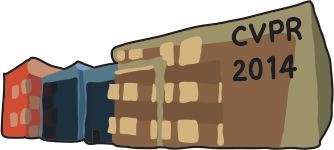-
What Camera Motion Reveals About Shape With Unknown BRDF
AbstractPsychophysical studies show motion cues inform about shape even with unknown reflectance. Recent works in computer vision have considered shape recovery for an object of unknown BRDF using light source or object motions. This paper addresses the remaining problem of determining shape from the (small or differential) motion of the camera, for unknown isotropic BRDFs. Our theory derives a differential stereo relation that relates camera motion to depth of a surface with unknown isotropic BRDF, which generalizes traditional Lambertian assumptions. Under orthographic projection, we show shape may not be constrained in general, but two motions suffice to yield an invariant for several restricted (still unknown) BRDFs exhibited by common materials. For the perspective case, we show that three differential motions suffice to yield surface depth for unknown isotropic BRDF and unknown directional lighting, while additional constraints are obtained with restrictions on BRDF or lighting. The limits imposed by our theory are intrinsic to the shape recovery problem and independent of choice of reconstruction method. We outline with experiments how potential reconstruction methods may exploit our theory. We illustrate trends shared by theories on shape from motion of light, object or camera, relating reconstruction hardness to imaging complexity.
Related Material
[pdf][bibtex]@InProceedings{Chandraker_2014_CVPR,
author = {Chandraker, Manmohan},
title = {What Camera Motion Reveals About Shape With Unknown BRDF},
booktitle = {Proceedings of the IEEE Conference on Computer Vision and Pattern Recognition (CVPR)},
month = {June},
year = {2014}
}
These CVPR 2014 papers are the Open Access versions, provided by the Computer Vision Foundation.
Except for the watermark, they are identical to the accepted versions; the final published version of the proceedings is available on IEEE Xplore.
Except for the watermark, they are identical to the accepted versions; the final published version of the proceedings is available on IEEE Xplore.
This material is presented to ensure timely dissemination of scholarly and technical work.
Copyright and all rights therein are retained by authors or by other copyright holders.
All persons copying this information are expected to adhere to the terms and constraints invoked by each author's copyright.

